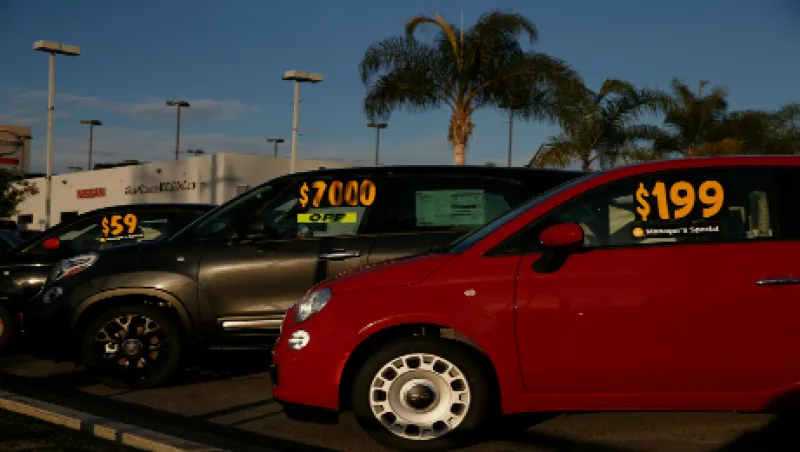The subprime auto-loan market is hitting some turbulence, and the woes will likely worsen, analysts say.
Some see the trouble mirroring the early problems of the subprime mortgage market coinciding with the 2007–’09 financial crisis. To be sure, the mortgage market is about 14 times larger than the auto-loan market, so no one expects subprime auto-loan difficulties to spark a major financial crisis. But the impact won’t be trivial, analysts agree.
Weak underwriting standards, predatory lending practices and fraud have created a bubble in the subprime auto-loan market, says Mark Williams, professor of finance at Boston University and a former bank examiner for the Federal Reserve. Once the bubble bursts, there will be consequences. “The subprime auto market appears small, but when you take into account a weak global economy already, you can see the impact of a single move, like last year’s yuan devaluation,” he says. “To say the subprime auto bubble is just an isolated occurrence is alarming.”
Subprime auto loans are variously defined as those made to people with credit scores below as high a ceiling as 640 and as low a ceiling as 600. Using a ceiling of 620, Equifax estimates there were $224.85 billion of subprime auto loans outstanding in February, the highest level since July 2008. The overall auto-loan market totaled $1.093 trillion in February.
The quality of the subprime loans, many of which have been pooled into bonds, is weakening. Loans packaged inside those securities during the past five years had a 60-day delinquency rate of 5.16 percent in February, the highest since October 1996, according to Fitch Ratings. And those delinquencies are leading to defaults. The default rate climbed to a six-year peak of 12.3 percent in January, according to Wells Fargo & Co.
The fundamental problems are an oversupply of credit in a low-interest-rate environment and a proliferation of subprime auto lenders, says Carlos Mendez, managing partner and co-founder at New York–based alternative-asset manager Crayhill Capital Management. Lenders include major banks, such as San Francisco’s Wells Fargo; private equity–sponsored firms, such as Irving, Texas–based Exeter Finance Corp., which is owned by New York’s Blackstone Group; and a slew of independent, smaller firms. One of the biggest lenders, Fort Worth, Texas–based Santander Consumer USA Holdings, is publicly traded.
Because of the industry’s elevated loan-loss rates and the high overhead costs to chase down loan payments, profit margins are small for lenders. “So you need volume,” Mendez says. As a result, there’s pressure to issue more and more loans. “And the next shoe to drop is your loan quality,” he says.
So it’s no great surprise that the weighted average credit score in loans rated by Standard and Poor’s last year was only 572, the lowest since the company began tracking the data in 2002. Also predictably, the drop in underwriting standards has been accompanied by an increase in interest rates. The weighted average rate registered 17.31 percent in 2015, the highest in six years, according to S&P.
Lenders also have increased loan durations to make monthly payments more affordable for borrowers. The percentage of loans with original maturities exceeding 60 months was 83.7 percent last year, up from 73.6 percent in 2010, according to S&P. The problem, of course, is that this gives the lenders more principal to lose. “It’s providing borrowers an opportunity not to pay you back, and they’re taking it,” Mendez says. Loan-to-value ratios also are increasing.
Meanwhile, the Federal Trade Commission has found evidence of predatory lending and fraud. The fraud has included falsified odometers and car dealers not informing customers of problems with the vehicles they purchase.
To structured-finance consultant Janet Tavakoli of Chicago, all of this makes subprime auto-loan securities a good shorting opportunity. “It’s similar to The Big Short in character, though not in magnitude,” she says, referring to the book and current movie about the billions earned by those who shorted subprime mortgage securities before the financial crisis.
Ratings agencies apparently disagree, since they haven’t downgraded subprime auto-loan securities, some of which are rated triple-A. Fitch, which rates securities issued only by Santander and General Motors Financial Co., has consistently upgraded their subordinate bonds in 2015 and so far this year. The deals pay down quickly, which results in greater credit enhancements, says Kevin Duignan, global head of securitization and covered bonds at Fitch. “Despite concerns about delinquencies, we feel our base-case expectations are conservative.”
He and others agree that the true test of the market will come during the next economic downturn. “In a recession, you have all this collateral coming back at you at once,” Mendez says. “The market’s not very resilient for that scenario.” And there could be a negative feedback loop for the economy in that a market meltdown would mean many people won’t have cars, which many need to travel to and from work.
A collapse of subprime auto lenders could turn into a systemic problem, as they infect other financial institutions with whom they do business. Says Boston University’s Williams: “It may not be a Lehman event, but it would have an impact.”







